March 9, 2016
by Lauren Nofi
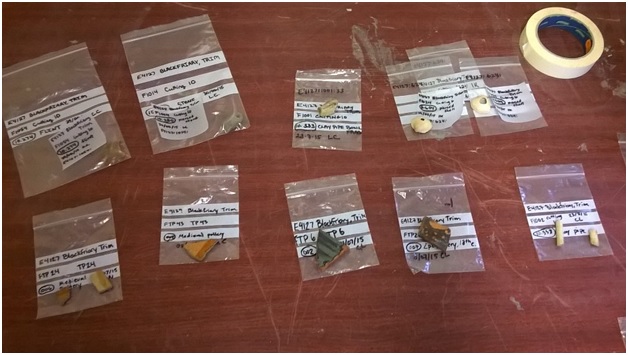
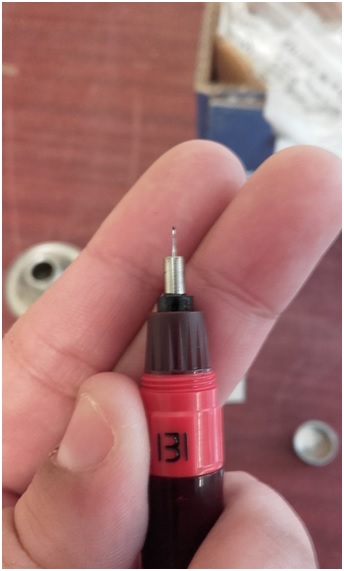
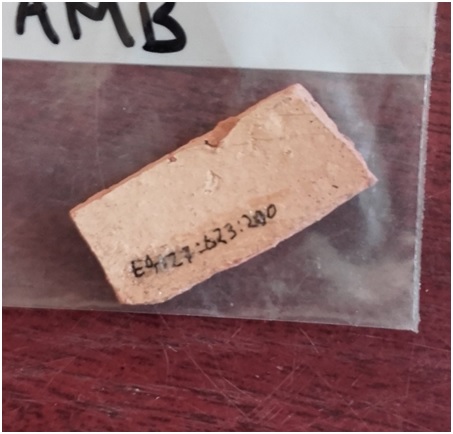
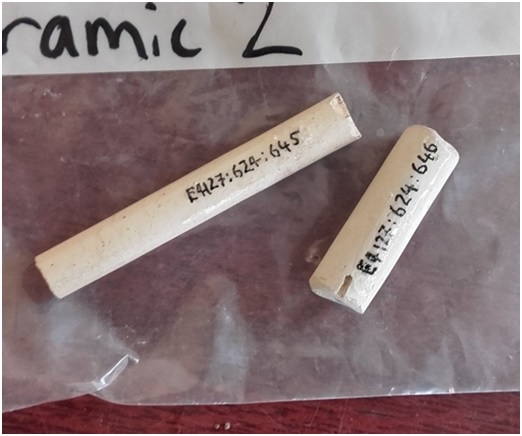
In the tenth (and penultimate) in a series of weekly blogs, IAFS/Learn intern Lauren Nofi reports on the progress in the post-excavation laboratory, looking at ceramics and the process of data entry.
Hey hey, this week was all about finishing registering and processing our last bits of ceramic as well as completing quite a bit of data entry. The last part of our processing of ceramic fragments involved some nimble fingers and a lot of patience…come to think of it so did all the data entry as well.
The site is rich with ceramic material, mostly in the form of pottery, though occasionally we get tiles and unidentifiable bits of fired clay. This pottery spans the entire occupation of the site, so we generally categorise our sherds as either medieval or post-medieval. This is a common practice on sites with multi-period use, and allows specialists to more easily find the physical artefacts as well as trace trends within the spatial use of the site through time. Every single fragment we have, just as with other artefacts, is assigned a unique number. This number includes the site code, feature number, and artefact number within said feature. For artefacts made of metal, we simply place a permatrace tag with each specimen. For pottery and tiles, however, we write our number directly on the sherd.
The actual process of pot-marking is simple enough in theory, but once you actually start working you’ll see it takes a special kind of archaeologist to really excel at labelling efficiently and legibly. I am not this type of archaeologist. 🙂
The first step to labelling a ceramic item is to inspect it for any special decoration or feature, something diagnostic (like whether it is from a rim or base. You can even determine the original size of the mouth or base of a vessel with these diagnostic pieces and a bit of maths). You definitely don’t want to write your artefact number on, say, the only visible bit of glaze since this later may be necessary for identification, or, even in some cases, reconstruction. Ideally, you would be writing the number along an edge on the inside surface of the vessel, which allows future display or reconstruction to be relatively unaffected by your labelling system. Sometimes it’s just not possible to determine an inner surface from an outer, or the shape of the sherd doesn’t allow for easy writing.
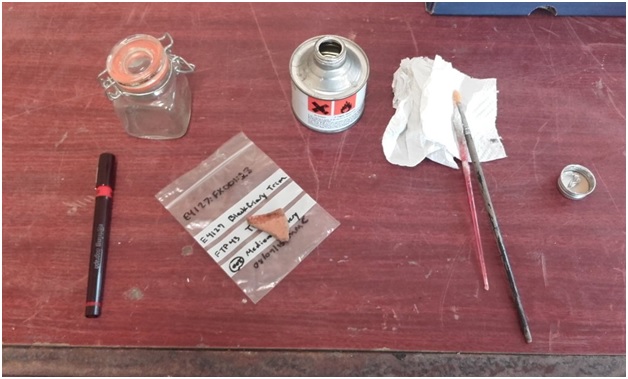
Tools of the trade: acetone (glass jar), varnish (tin), special and practically magical tiny-nib pen, and some brushes.
Once you’ve found a surface to label, you must place a thin strip of a special multi-purpose fixative: it’s basically a varnish, consolidant and glue all in one which conservators call B72. When this dries, you add another layer of varnish. You’ve now made a writing surface which is removable, as reversibility is incredibly useful. This particular varnish can be removed with acetone, so if something must be re-labelled, a quick swipe of acetone and gentle scrub gives back your original ceramic surface no worse for wear. Next, you use a pen, often a specialised one with a very thin nib, to write your artefact numbers on your varnish stripe. One final coat of varnish and your find is now identifiable.
Fellow intern Ciarán and I developed a nice little assembly line of artefacts in various states of labelling. I handled the measurement for registering and varnishing, while he entered the measurements into our digital ledger and wrote the actual numbers.
I should say it wasn’t just potsherds and tiles in our ceramic collection, I did leave out my favourite type of object: clay pipe fragments. They are my favourite simply as nearly every site I have worked on has amassed nice collections of pipe stems and pipe bowls. These functional and occasionally even decorative objects begin their historical life in the colonial period of Britain concurring with the tobacco trade. Some specialists have actually used the dimensions of the pipe stem bore-hole and the bowl as markers for dating the artefact; in general, smaller bowls are often earlier due to the very low quantities of tobacco available in the first centuries of the industry. By the 1790s, clay pipes were also made into extravagant collectors’ items, with multicoloured glazes and extended hollow chambers. One type of these decorative pipes is known as Prattware and some feature comical heads and bodies curving to form the stem and bowl. Some of it is truly hideous (so naturally I love it). Our simple clay pipe fragments however have contemporary analogues all over the world, especially wherever the British tobacco industry reached (yes, I know we are in Ireland, but you have to think of major players in the beginnings of globalised trade and the influence of British law and socio-economics on Ireland).
My other work this week involved lots of computer work. I spent some time populating tables for all our cuttings listing the artefacts and ecofacts found therein for our upcoming site report. In addition, I collated information on all of our outreach activities since our founding as IAFS, also for our report. Lastly, I digitised our burials register, creating a searchable spreadsheet of all of our articulated inhumations.
Until next week!
Comments are closed.
Dorothy Griffiths
I am impressed by your finds report. It reminded me of my archaeological work as an Archaeologist working in the Finds Unit in Jamaica where I am from originally. As you name each ceramic fine in detail it just made me reminiscent over excavating, bagging an labelling the artifacts as we would find a massive array of Post-Medieval Ceramics, The excitement would heighten as we returned to the lab to wash, relabel and analyse the finds.
I wanted to join a Filed School in Scotland in Summer 2019 but no one responded to my email when I reached out. Be that as it may I have been attending the Current Archaeology Conferences in London since 2019, and I enjoy it and that has made me more convinced that Archaeology is what I should continue to pursue as my career. I am especially excited about working with Post-Medieval Ceramics which is my strongest skill.